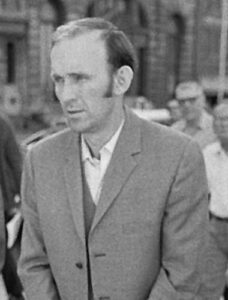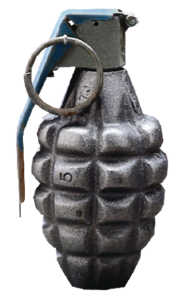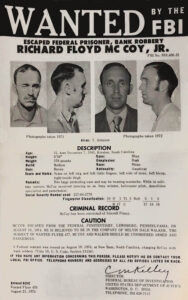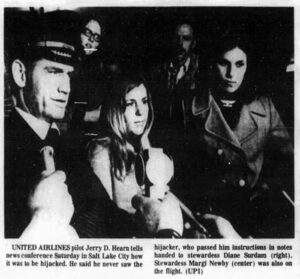On April 7, 1972, Richard Floyd McCoy, Jr. hijacked a United Airlines flight and parachuted from the plane over Utah with ransom money. This was one of the best-known of the D.B. Cooper copycat hijackings, but this time, FBI agents would track down the hijacker.
On that day, United Airlines Flight 855, a Boeing 727, was en route from Newark, New Jersey, to Los Angeles, California, with 85 passengers and a crew of six. The plane landed in Denver, Colorado, for a stopover when Richard Floyd McCoy boarded the flight. Approximately 20 minutes after takeoff, at 5:18 p.m., McCoy was observed in his seat holding a hand grenade.
A stewardess, notified of the situation, immediately advised the captain. An off-duty pilot known to be on board as a passenger was requested to discreetly walk around and assess the situation, only to have McCoy draw a pistol as he approached. The gunman handed over a sealed envelope labeled “hijack instructions” and stated, “Give this envelope to the girl and have her take it to the captain.” A stewardess complied, and the off-duty pilot returned to his seat.
The events had transpired so quickly that most passengers were unaware of the threat. Captain Gerry D. Hearn discussed the matter with some crew members and decided to land at nearby Grand Junction, Colorado, where he would radio for law enforcement assistance on the ground. Captain Hearn then announced over the public address system that the aircraft was experiencing a “minor mechanical problem” and would land shortly.
The captain then opened the envelope with the hijack instructions. Inside were two typed pages of highly detailed directions, a hand grenade pin, and a bullet. The “instructions” required Hearn to land at San Francisco International Airport and park at “Runway 19 left.” There, he was to follow specific procedures which designated the number of people allowed near the plane at one time and the distance from the aircraft that all vehicles other than those containing fuel were to be kept. In addition, the hijacker demanded $500,000 in cash, four parachutes, and the return of all written or typed directions given during the course of the flight.
The crew decided to comply and notified San Francisco of the hijacking and intended landing. A flight crew member announced to the passengers that the Grand Junction airport could not handle the “necessary repairs” after all, and it would be necessary to divert to San Francisco, California. From this point on, normal operations continued on board until the plane landed at 4:15 p.m., where it taxied to a remote runway bordering San Francisco Bay.
Considering the safety of all aboard Flight 855, United Air Lines officials decided to meet the demands upon the plane’s landing in San Francisco. Two flight bags loaded with cash and four parachutes were delivered to the plane.
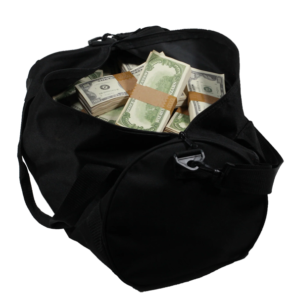 The hijacker, who had assumed command on touchdown, gave up his baggage check and had his luggage brought aboard. Fuel trucks hurriedly filled the plane’s tanks with thousands of gallons of jet fuel. After seeing the completion of his written directions, about three hours after the plane had parked, the gunman released the 85 passengers and one of the stewardesses. He then ordered the rest of the crew into the cockpit and took a position in the rear of the aircraft.
The hijacker, who had assumed command on touchdown, gave up his baggage check and had his luggage brought aboard. Fuel trucks hurriedly filled the plane’s tanks with thousands of gallons of jet fuel. After seeing the completion of his written directions, about three hours after the plane had parked, the gunman released the 85 passengers and one of the stewardesses. He then ordered the rest of the crew into the cockpit and took a position in the rear of the aircraft.
The hijacker then used the intercom to summon a stewardess. He gave her another set of flight instructions, telling the pilot to take off towards the east, climb to 16,000 feet, and fly precisely at 200 mph on a course that would overpass several specific Utah communities. The messages, now hand-printed, between hijacker and pilot were sent with increasing frequency, always using the stewardess as a courier. The cabin was ordered depressurized, and the gunman warned that if any pursuit planes were spotted, he would detonate a hidden explosive device after he had jumped before the plane could be landed.
In the meantime, the California Highway Patrol told its officers throughout Northern California to be on the alert for “flares and parachutes.” Two supersonic F‐104 jets were ordered from the Hamilton Air Force Base to shadow the jetliner.
The hijacker opened his luggage and covered the peephole between the cockpit and cabin. Observed by Second Officer K. W. Owen through a slight space under the cockpit door, the hijacker quickly put on a jumpsuit, helmet, and parachute. Once he had shut off the cabin lights to view the ground better, the gunman demanded to be kept abreast of wind, ground, air speeds, altimeter settings, and sky conditions.
After the aircraft passed over the last Utah community on his prescribed course, the hijacker sent no more notes. Hoping the incident was over, a stewardess ventured into the passenger area. She determined the gunman had bailed out the rear exit with the ransom in north-central Utah’s rugged canyon lands. Helicopters and jeep posses were soon headed into the area.
Five hours after the hijacking began, the weary crew headed for nearby Salt Lake City International Airport.
Upon landing, the FBI immediately searched the plane’s interior for evidence. Any object the hijacker may have touched was examined. An array of materials such as seat belts, gum wrappers, cigarette butts, and a copy of United’s passenger publication, Mainliner Magazine, was gathered by agents. One hand-printed note the hijacker neglected to take with him was also sent to the FBI Laboratory in Washington, D.C., for closer scrutiny. It was found that the hand grenade was actually a paperweight resembling a hand grenade.
Interviews with crew members and passengers traced the hijacker’s steps from the moment he boarded. The bespectacled, mustached man was described as being between 20 and 25 years old. He was about 5 feet 10 inches tall, weighed 160 to 170 pounds, and wore a dark suit, black leather gloves, and a wig.
Other passengers and crew remembered a passenger agent had entered the plane after all had boarded at Denver to locate the owner of an envelope left in the waiting room. The subject claimed it, went into the lavatory for an extended period, and finally was told by a flight officer to return to his seat for takeoff. The consensus was that the individual had donned a wig and mustache while in the lavatory. However, several passengers felt that more than one person was involved. The notes received by the crew generally used the terminology of “we this” or “we that,” thus giving this impression.
A search of the countryside near the Provo, Utah Airport was conducted since evidence indicated that the hijacker had bailed out in the area.
At approximately 2:00 a.m. the next day, FBI agents, Provo City Police, and the Utah County Sheriff’s posse lined up some 20 to 30 yards apart and combed the surrounding fields.
The night dragged on with no new leads being developed. Within a few hours, though, area residents woke up to news of the hijacking. The Salt Lake City Office of the FBI received a telephone call before noon from a concerned citizen who said an acquaintance had outlined a “foolproof” plan for hijacking an airplane.
The acquaintance, Richard Floyd McCoy, Jr., was a Vietnam Veteran who had served two tours of duty, a helicopter pilot with the Green Berets, and an avid and capable skydiver. McCoy, 29, was reportedly a Utah Air National Guard member and a Police Science Major at Brigham Young University, with aspirations of becoming a Utah State Trooper. In addition, McCoy was generally known to be having severe financial problems.
The Department of the Army was requested to furnish samples of McCoy’s handwriting from its records to the FBI Laboratory since the citizen provided additional valuable information in a more detailed personal interview.
McCoy was located and interviewed by FBI agents but denied any participation in, or prior knowledge of, the hijacking. He gave the agents a sample of his hand printing to be compared later with the style in the note the hijacker left behind. McCoy continued to claim innocence and was not detained.
Meanwhile, the FBI Laboratory had been busy with evidence already received. A handwriting expert compared the note on the plane with McCoy’s writing on military service records and determined that McCoy had written the note. Fingerprint specialists discovered that a latent print on the Mainliner Magazine in the seat next to the hijacker’s matched a print from McCoy during his service year.
More evidence was found when a 14-year-old boy from Provo, Utah, made a surprising discovery. Lying in front of him, beside a steel culvert, was what he thought might be a parachute pack. He brought the strange object to his father, who was replacing a flat tire on the family car a short distance away. After returning home that afternoon, the father notified the local sheriff of their find. It was soon learned that the item was one of the four parachutes furnished to a lone gunman who had hijacked a passenger plane in the Colorado skies on April 7, 1972.
Incriminating evidence mounted against McCoy. In trying to trace the steps the hijacker took after parachuting into the rural area surrounding Provo, a lead was developed. When shown McCoy’s photograph, an employee at a roadside hamburger stand said she had sold him a milkshake at about 11:30 on the night of the crime. In addition, a teenager stated that a man fitting McCoy’s description paid him five dollars for a ride from the stand to a nearby town.
On April 9, a federal complaint charged McCoy with aircraft piracy and interfering with flight crew members.
Later the same day, an arrest warrant was obtained, and McCoy was taken into custody by FBI agents at his Provo home. Agents examined the accused’s home under a search warrant. They uncovered various articles of skydiving equipment, an electric typewriter with key impressions matching those on the typed hijacking instructions, and $499,970 in U.S. currency. A federal grand jury in Salt Lake City indicted McCoy on April 14.
Two months later, McCoy, found to have acted alone, was tried in the U.S. District Court and found guilty despite his claim of innocence. He was subsequently sentenced to a term of 45 years.
McCoy appealed the decision to the U.S. Supreme Court, which denied his petition on October 9, 1973.
Two years later, he escaped from Lewisburg Federal Penitentiary with several accomplices by crashing a garbage truck through the main gate. Tracked down three months later in Virginia Beach, Virginia, McCoy was killed in a shootout with FBI agents in 1974.
Compiled by Kathy Alexander/Legends of America, updated October 2023.
Also See:
The Fatal Flight of United Airlines 629
Sources:


